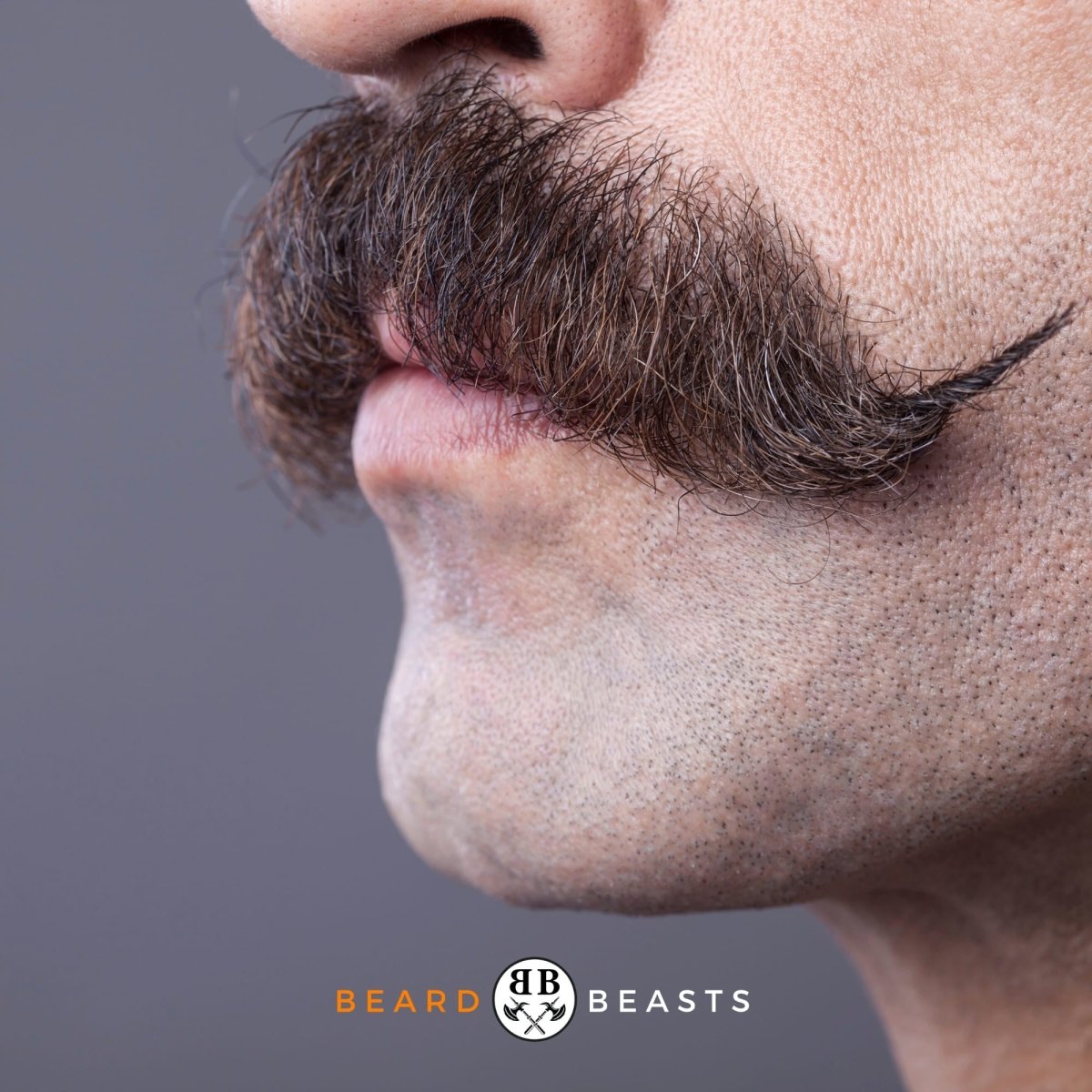Welcome to the ultimate guide on how to train your mustache, a comprehensive journey into the world of mustache grooming and styling.
Whether you’re a grooming novice or looking to refine your mustache game, this article is packed with essential tips on how to train your mustache, like the best tools, and techniques to help you grow and style your mustache with confidence. From understanding the basics of mustache growth to selecting the right grooming products, and mastering stylish looks, we’ve got you covered.
Dive into our expert advice to discover how to enhance your facial hair’s appearance, manage common grooming challenges, and tailor your mustache care routine to suit your unique style.
Get ready to embark on a grooming adventure that will transform your mustache into a statement of personal style and sophistication.

Understanding Mustache Growth
Before we begin your journey on how to train your mustache, it is important to quickly touch on understanding mustache growth, its influencing factors, and setting realistic expectations. Dive in for a concise guide to kickstart your grooming adventure.
The Basics of Mustache Growth
Growing a mustache is a journey unique to each individual, heavily influenced by genetics, lifestyle, and health. The key to training your mustache starts with understanding how it grows. Each hair follicle on your face is programmed to grow hair at its own pace and thickness, which is why patience and care are crucial in achieving your desired look.
Factors Influencing Mustache Growth
- Genetics: Your genes play the most significant role in determining hair growth rate, density, and color.
- Age: Younger men may find their mustaches grow more sparsely, but density can increase with age.
- Health and Nutrition: A balanced diet rich in vitamins and minerals supports healthy hair growth.
- Lifestyle: Stress, smoking, and poor sleep can negatively impact your mustache’s health and growth.
Understanding Different Mustache Types
Mustaches come in various shapes and sizes, from thin and fine to thick and bushy. Recognizing your mustache type is essential for training it effectively. Some might aim for a sleek, groomed look, while others prefer a more natural, rugged style. Knowing your type helps in selecting the right grooming tools and products.
Setting Realistic Expectations
Growth timelines vary widely, with most men needing a few months to grow a substantial mustache. Initial stages might look uneven or sparse, but with time and proper care, gaps often fill in. Patience is your best friend during this phase, as rushing the process can lead to frustration.
What to Expect
- Weeks 1-4: The awkward phase, where growth might look patchy.
- Months 1-3: You’ll start to see what your mustache can become, allowing for initial styling and training.
- Beyond 3 Months: With regular grooming, your mustache should be well-established, enabling more complex styling and shaping.
In your quest on how to train your mustache, remember that growth and maintenance are ongoing processes. With the right approach, you can cultivate a mustache that not only suits your style but also enhances your overall look. Keep these insights in mind as you nurture and style your growing mustache for the best results.
Essential Tools and Products for Mustache Training
Learning how to train your mustache, involves equipping yourself with the right tools and products is crucial. This selection can make or break your grooming routine, ensuring your mustache not only looks great but feels healthy too.
Must-Have Grooming Tools
- Combs and Brushes: A mustache comb is essential for detangling and styling your facial hair, while a beard boar bristle brush can distribute oils evenly and keep hairs in line. Opt for a comb with fine teeth for precision.
- Scissors and Trimmers: For maintaining length and shape, high-quality scissors are perfect for precise cuts. For efficient bulk management and defining edges, we recommend the Philips Norelco Series 9000 Trimmer. It’s designed for precision and comfort, making it an ideal choice for mustache grooming.
Mustache Care Products
- Waxes: Mustache wax is key for styling and holding your mustache in place, especially for achieving shapes like the handlebar. Look for waxes that match your hold preference and scent liking. Shop Mustache Wax ➵
- Oils and Balms: These products are vital for moisturizing and conditioning your mustache, promoting healthy growth and preventing itchiness. Beard oils offer a lighter touch, while beard balms provide more substantial conditioning.
- Shampoos: Specialized facial hair washes cleanse and soften your mustache, keeping the skin underneath healthy and comfortable. Shop Beard Wash ➵
Choosing the Right Products for Your Mustache Type
Selecting products that match your mustache type and skin sensitivity is important. Thick, wiry mustaches may require heavier balms and strong-hold waxes, whereas finer hair benefits from lighter oils and soft waxes. Always consider your skin’s needs too, opting for products with natural ingredients if you’re prone to irritation.
With these tools and products in your grooming arsenal, you’re well on your way to mastering how to train your mustache.
Remember, the key to a well-groomed mustache is not just the products you use but how you use them. Regular grooming, combined with the right tools and products for your specific mustache type, will ensure your facial hair remains healthy, styled, and under control.
Techniques on How To Train Your Mustache
Training your mustache is a key step in achieving the look you want. Whether you’re aiming for a refined appearance or a more natural style, the right techniques can make all the difference. Here’s how to get started with basic training and advance to more specialized styling.
Basic Training Techniques
Daily Combing and Brushing Routines: Regular combing helps train your mustache hairs to grow in the desired direction and can prevent tangling. Use a fine-toothed comb for precision. Brushing with a quality mustache brush distributes natural oils and keeps your mustache looking neat.
Applying Wax for Shape and Hold: Mustache wax is essential for maintaining your style throughout the day. Warm a small amount between your fingers, apply it to your mustache, and shape as desired. For beginners, start with a light application and adjust the amount based on your mustache’s length and thickness. Shop Mustache Care ➵
Advanced Styling Tips
Shaping Your Mustache for Your Face Type: The best mustache style complements your face shape. Round faces benefit from slender, angular mustaches to elongate the face, while angular faces can soften with fuller mustaches. Experiment to find what enhances your features.
Techniques for Thick, Thin, Long, and Short Mustaches: Each mustache type requires a different approach. Thick mustaches may need more wax and regular trimming to maintain shape, while thin mustaches benefit from lighter oils to appear fuller. Long mustaches can be styled with twists or curls at the ends, whereas short mustaches require precise trimming for a clean edge.
In your quest on how to train your mustache, remember that consistency is key. Regular grooming, coupled with the right techniques for your mustache type and face shape, will ensure your mustache not only looks great but also reflects your personal style.
Keep practicing these techniques, and don’t be afraid to experiment with different styles and products to discover what works best for you.
Mustache Styles and How to Achieve Them
Exploring different mustache styles is an exciting part of the grooming journey. Whether you’re aiming for a classic look or something more distinctive, mastering a few popular styles can transform your appearance. Here’s how to achieve some of the most iconic mustache styles and the steps to style them effectively.
Popular Mustache Styles
- The Chevron: Thick and wide, the Chevron covers the top lip and is a classic, straightforward style. Think Tom Selleck’s iconic look for inspiration.
- The Handlebar: Known for its twisted ends that curl upwards, the Handlebar adds a touch of elegance and vintage flair.
- The Walrus: A bushy, full mustache that hangs over the lip, the Walrus is for those who prefer a rugged, natural look.
- The Pencil: Thin and neatly trimmed, the Pencil mustache offers a subtle and refined appearance, reminiscent of classic Hollywood.
Step-by-Step Guide to Styling
Preparing Your Mustache:
- Start with a clean, dry mustache. Wash with a specialized shampoo and conditioner to soften hairs, making them easier to style.
Shaping and Trimming:
- For the Chevron and Walrus, use scissors or a trimmer to create a natural shape that follows the line of your upper lip, trimming any hairs that hang over.
- The Handlebar and Pencil styles require more precise shaping. Define the edges with a trimmer, then use wax to sculpt the Handlebar’s curls or maintain the Pencil’s slim line.
Finishing Touches:
- Apply mustache wax if needed to hold the shape, using a comb to distribute the product evenly for styles like the Chevron and Walrus.
- For the Handlebar, twist the ends and curl them upward, applying extra wax for hold. The Pencil mustache might only need a light touch of wax to keep the lines defined.
In learning how to train your mustache, remember that achieving the perfect style takes practice and patience. Don’t be discouraged by initial setbacks; every grooming session brings you closer to mastering your desired look. Experiment with different styles to discover what best suits your face shape and personal preference, ensuring your mustache becomes a signature part of your style.
Daily and Long-Term Mustache Care
Maintaining a well-groomed mustache requires a commitment to a daily and long-term care routine. Proper care not only keeps your mustache looking its best but also addresses common issues that many face along the way. Here’s a straightforward guide to establishing a mustache care routine that will keep your facial hair healthy and stylish.
Establishing a Mustache Care Routine
Cleaning: Keeping your mustache clean is fundamental. Use our Ultra Soft Beard Wash to wash your mustache a few times a week to remove daily dirt and grime without stripping natural oils.
Moisturizing: After washing, apply a quality beard oil like our Gold Beard Oil to moisturize both the hair and the skin underneath. This prevents dryness and keeps your mustache soft and manageable.
Trimming: Regular trimming helps maintain the shape and length of your mustache. Whether you’re keeping a precise style like the Pencil or a more natural look like the Walrus, use the right tools to trim any beard hairs sticking out or overlong hairs.
Dealing with Common Mustache Issues
Itchiness and Irritation: Often caused by dry skin under your mustache, moisturizing with beard oil can relieve itchiness. If the problem persists, consider using products with natural ingredients to minimize irritation.
Uneven Growth: Patience is key for uneven growth. Continue grooming and give your mustache time to fill in. Regular combing and application of growth-promoting oils can also help.
Styling Challenges: If your mustache doesn’t stay in place or achieve the desired shape, experiment with different waxes and styling techniques. Remember, practice makes perfect, and finding the right product for your hair type can make a significant difference.
In your journey on how to train your mustache, incorporating these daily and long-term care practices will ensure your mustache remains a highlight of your personal style. Adapt your routine as needed based on your lifestyle, mustache type, and any issues you encounter.
With the right care, your mustache can become a defining feature of your look, reflecting both your personality and grooming prowess.
Health, Hygiene, and Beyond
A well-maintained mustache is not just about appearance; it’s also about promoting good hygiene and health. Taking care of your mustache goes beyond simple grooming—it involves practices that ensure both your mustache and the skin beneath it are healthy. Here are essential tips for keeping your mustache clean and healthy.
Keeping Your Mustache Clean
Proper Washing Techniques: Use a mild, beard-specific shampoo to gently cleanse your mustache. Avoid regular hair shampoos, which can be too harsh and strip away natural oils. Wash 2-3 times a week, depending on your lifestyle and environment.
Dealing with Food: Eating with a mustache can be challenging. After meals, rinse or wipe your mustache to remove food particles. A mustache wax can also help by keeping hairs away from your mouth.
Mustache Health Tips
Skin Health Under Your Mustache: The skin under your mustache requires attention to prevent dryness and flakiness. Hydrate the skin with beard oils or balms that reach the skin beneath to nourish and moisturize.
Signs of Unhealthy Mustache or Skin: Be on the lookout for itching, redness, or excessive flaking, which could indicate an underlying issue like dermatitis. If you notice persistent problems, consider switching to hypoallergenic products or consult a dermatologist.
In mastering how to train your mustache, remember that health and hygiene are foundational. A clean, healthy mustache not only looks better but also feels more comfortable, enhancing your overall grooming experience.
By incorporating these health and hygiene practices into your daily routine, you ensure that your mustache remains a symbol of both style and well-being.
FAQs and Troubleshooting
Embarking on the journey of mustache training comes with its share of questions and challenges. Here, we address some frequently asked questions and common problems you might encounter, offering solutions to help you navigate the path to a well-groomed mustache with confidence.
Frequently Asked Questions
How long does it take to train a mustache? It varies depending on your hair growth and the style you’re aiming for. Generally, noticeable results can be seen within a few weeks, but fully training your mustache might take a few months of consistent care and grooming.
Can I make my mustache grow faster? While genetics play a significant role in growth rate, maintaining a healthy diet, staying hydrated, and using products designed to stimulate hair growth can potentially speed up the process.
What if my mustache is patchy? Give it time. Many mustaches fill in with patience and age. In the meantime, you can use styling techniques and products to camouflage patchiness.
Troubleshooting Common Problems
Styling Mishaps: If you’ve applied too much wax or your mustache isn’t holding its shape, warm a small amount of oil in your hands and run it through your mustache to reset. Start styling again with a smaller amount of wax.
Growth Issues: For uneven growth, ensure you’re following a healthy lifestyle and consider using a beard serum to encourage growth. Regular trimming can also help by promoting even growth over time.
Itchiness and Irritation: This is often due to dry skin. Hydrate the area with a good quality beard oil or balm. If the problem persists, switch to hypoallergenic or unscented products to see if it makes a difference.
Remember, the journey to a well-trained mustache is unique for everyone. Patience, consistency, and the right care routine are your best allies. Whether you’re dealing with styling challenges or growth concerns, there’s usually a solution or a workaround to help you achieve the look you desire. Keep experimenting with different products and styles, and don’t hesitate to seek advice from grooming professionals if you’re facing persistent issues.
Concluding How To Train Your Mustache
Learning how to train your mustache is a rewarding journey that enhances your style and personal expression. Throughout this guide, we’ve covered the essentials from understanding mustache growth, selecting the right grooming tools and products, to mastering various styling techniques and addressing common grooming challenges. Remember, the key to a well-trained mustache lies in consistency, patience, and care.
Every mustache is unique, and what works for one person may not work for another. Therefore, we encourage you to experiment with different styles, products, and routines to discover what best suits your mustache type and personal preference. Whether you’re aiming for a sleek Chevron, a sophisticated Handlebar, or any style in between, there’s a wealth of possibilities waiting for you to explore.
As you continue on your quest on how to train your mustache, don’t be afraid to embrace the learning curve. With each grooming session, you’ll gain more insight into what makes your mustache thrive. Keep in mind that a well-groomed mustache is not just about appearance; it’s a testament to your dedication to self-care and grooming excellence.
In closing, remember that training your mustache is an art and a science—requiring both creativity and understanding. With the guidance provided in this article and your ongoing commitment, you’re well on your way to achieving a mustache that not only looks great but also reflects your unique personality and style. Here’s to your mustache training success!





